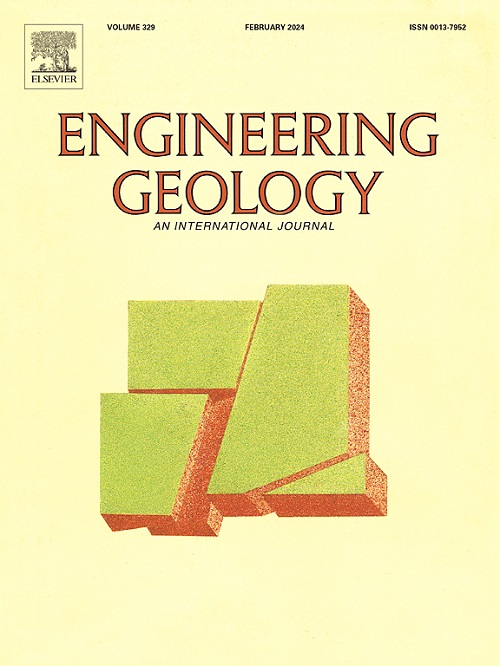DFN modeling incorporating fracture stratigraphy constraints into the stereology inverse problem
IF 6.9
1区 工程技术
Q1 ENGINEERING, GEOLOGICAL
引用次数: 0
Abstract
We develop a methodology for building stochastic discrete fracture networks (DFNs) based on the solution of a generalized version of the stereology inverse problem incorporating constraints derived from fracture stratigraphy. The DFN is simulated inside a layer-cake model, whose interfaces conform to the available fracture stratigraphy information. For each layer, estimates of the power law exponent of fracture sizes and volumetric fracture intensity () are obtained for each fracture set from the solution of the inverse problem; the inputs are trace length distribution and areal fracture intensities () measured on multiple exposed surfaces. A Lagrangian formulation of the inverse problem allows the straightforward incorporation of geological constraints. However, the price to pay is having to solve the problem with global optimization methods; here we use a particle swarm optimization algorithm. Our approach is applied in a real cave setting, where multiple surfaces expose fracture traces. Using a simplified geometry of the cave setting, we obtain solutions honoring both synthetic and field measurements. Uncertainties in the estimates might be different for each layer, depending on the fracture intensity contrasts between the layers and on the angles between the exposed surfaces and the fracture planes. The interpreter can then evaluate the reliability of the parameter estimates obtained with the layer-cake model in comparison with those obtained with a homogeneous version of the investigated volume. In addition, we show that the estimates depend on the shape assumed for the fractures, being larger for rectangle-shaped fractures than for disk-shaped fractures.
求助全文
约1分钟内获得全文
求助全文
来源期刊

Engineering Geology
地学-地球科学综合
CiteScore
13.70
自引率
12.20%
发文量
327
审稿时长
5.6 months
期刊介绍:
Engineering Geology, an international interdisciplinary journal, serves as a bridge between earth sciences and engineering, focusing on geological and geotechnical engineering. It welcomes studies with relevance to engineering, environmental concerns, and safety, catering to engineering geologists with backgrounds in geology or civil/mining engineering. Topics include applied geomorphology, structural geology, geophysics, geochemistry, environmental geology, hydrogeology, land use planning, natural hazards, remote sensing, soil and rock mechanics, and applied geotechnical engineering. The journal provides a platform for research at the intersection of geology and engineering disciplines.
 求助内容:
求助内容: 应助结果提醒方式:
应助结果提醒方式:


